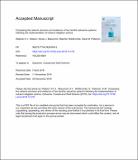Files in this item
Comparing the network structure and resilience of two benthic estuarine systems following the implementation of nutrient mitigation actions
Item metadata
| dc.contributor.author | Watson, Stephen C. L. | |
| dc.contributor.author | Beaumont, Nicola J. | |
| dc.contributor.author | Widdicombe, Stephen | |
| dc.contributor.author | Paterson, David M. | |
| dc.date.accessioned | 2020-01-07T00:36:17Z | |
| dc.date.available | 2020-01-07T00:36:17Z | |
| dc.date.issued | 2019-01-07 | |
| dc.identifier | 257340025 | |
| dc.identifier | 397e53b4-8ecb-4d1d-bce1-ab99796ab997 | |
| dc.identifier | 85059669654 | |
| dc.identifier | 000577973600006 | |
| dc.identifier.citation | Watson , S C L , Beaumont , N J , Widdicombe , S & Paterson , D M 2019 , ' Comparing the network structure and resilience of two benthic estuarine systems following the implementation of nutrient mitigation actions ' , Estuarine, Coastal and Shelf Science , vol. In press . https://doi.org/10.1016/j.ecss.2018.12.016 | en |
| dc.identifier.issn | 0272-7714 | |
| dc.identifier.other | RIS: urn:C4A30E43A8014817E10DA4B7D24C4C27 | |
| dc.identifier.other | ORCID: /0000-0003-1174-6476/work/52888708 | |
| dc.identifier.uri | https://hdl.handle.net/10023/19235 | |
| dc.description | This work [NERC Grant Ref: NE/K501244/1] was funded with support from the Biodiversity and Ecosystem Service Sustainability (BESS) programme. BESS is a six-year programme (2011–2017) funded by the UK Natural Environment Research Council (NERC) and the Biotechnology and Biological Sciences Research Council (BBSRC) as part of the UK's Living with Environmental Change (LWEC) programme. This work presents the outcomes of independent research funded by the Natural Environment Research Council through the Biodiversity and Ecosystem Service Sustainability (BESS) programme. DMP also received funding from the MASTS pooling initiative (The Marine Alliance for Science and Technology for Scotland) and their support is gratefully acknowledged. MASTS is funded by the Scottish Funding Council (grant reference HR09011) and contributing institutions. | en |
| dc.description.abstract | The structure and resilience of benthic communities in coastal and estuarine ecosystems can be strongly affected by human mediated disturbances, such as nutrient enrichment, often leading to changes in a food webs function. In this study, we used the Ecopath model (EwE) to examine two case studies where deliberate management actions aimed at reducing nutrient pollution and restoring ecosystems resulted in ecological recovery. Five mass-balanced models were developed to represent pre and post-management changes in the benthic food web properties of the Tamar (1990, 1992, 2005) and Eden (1999, 2015) estuarine systems (UK). The network functions of interest were measures related to the cycling of carbon, nutrients and the productivity of the systems. Specific attention was given to the trophic structure and cycling pathways within the two ecosystems. The network attribute of ascendency was also examined as a proxy for resilience and used to define safe system-level operating boundaries. The results of the resilience metrics ascendancy (A) and its derivatives capacity (C) and overhead (O) indicate that both systems were more resilient and had higher resistance to potential stressors under low nutrient conditions. The less perturbed networks also cycled material more efficiently, according to Finns cycling index (CI), and longer cycling path lengths were indications of less stressed systems. Relative Ascendency (A/C) also proved useful for comparing estuarine systems of different sizes, suggesting the Tamar and Eden systems network structures have remained within their pre-defined “safe operating zones”. Overall, this analysis presents justification that efforts to reduce nutrient inputs into the Tamar and Eden estuaries have had a positive effect on the trophic networks of each system. Moreover, the consensuses of the network indicators in both systems suggest ecological network analysis (ENA) to be a suitable methodology to compare the recovery patterns of ecosystems of different sizes and complexity. | |
| dc.format.extent | 2005608 | |
| dc.language.iso | eng | |
| dc.relation.ispartof | Estuarine, Coastal and Shelf Science | en |
| dc.subject | Comparative studies | en |
| dc.subject | Ecopath with Ecosim | en |
| dc.subject | Estuary | en |
| dc.subject | Eutrophication | en |
| dc.subject | Network analysis | en |
| dc.subject | QH301 Biology | en |
| dc.subject | NDAS | en |
| dc.subject.lcc | QH301 | en |
| dc.title | Comparing the network structure and resilience of two benthic estuarine systems following the implementation of nutrient mitigation actions | en |
| dc.type | Journal article | en |
| dc.contributor.sponsor | NERC | en |
| dc.contributor.institution | University of St Andrews. School of Biology | en |
| dc.contributor.institution | University of St Andrews. Sediment Ecology Research Group | en |
| dc.contributor.institution | University of St Andrews. Marine Alliance for Science & Technology Scotland | en |
| dc.contributor.institution | University of St Andrews. Scottish Oceans Institute | en |
| dc.contributor.institution | University of St Andrews. St Andrews Sustainability Institute | en |
| dc.identifier.doi | 10.1016/j.ecss.2018.12.016 | |
| dc.description.status | Peer reviewed | en |
| dc.date.embargoedUntil | 2020-01-07 | |
| dc.identifier.grantnumber | NE/J015644/1 | en |
This item appears in the following Collection(s)
Items in the St Andrews Research Repository are protected by copyright, with all rights reserved, unless otherwise indicated.

